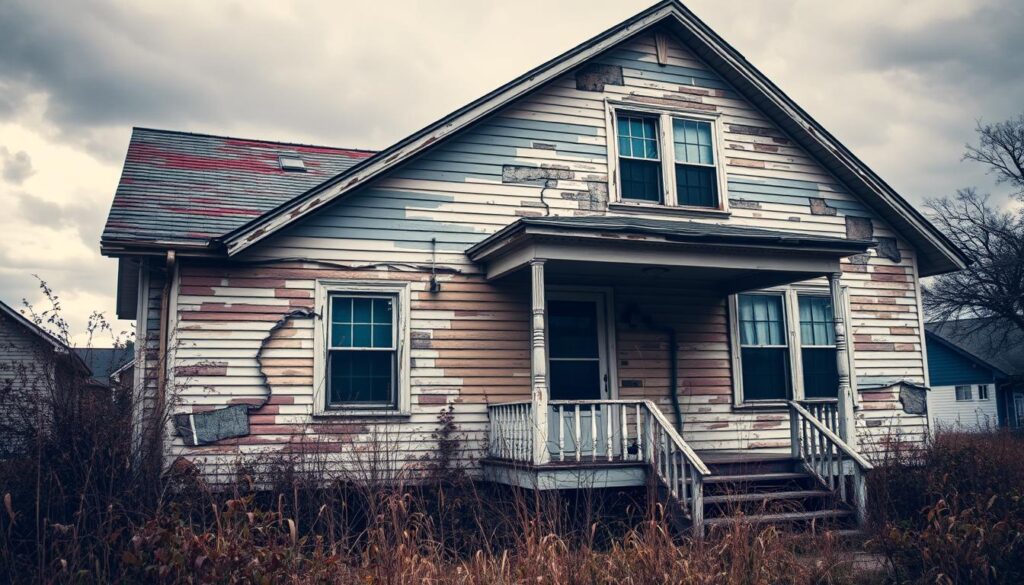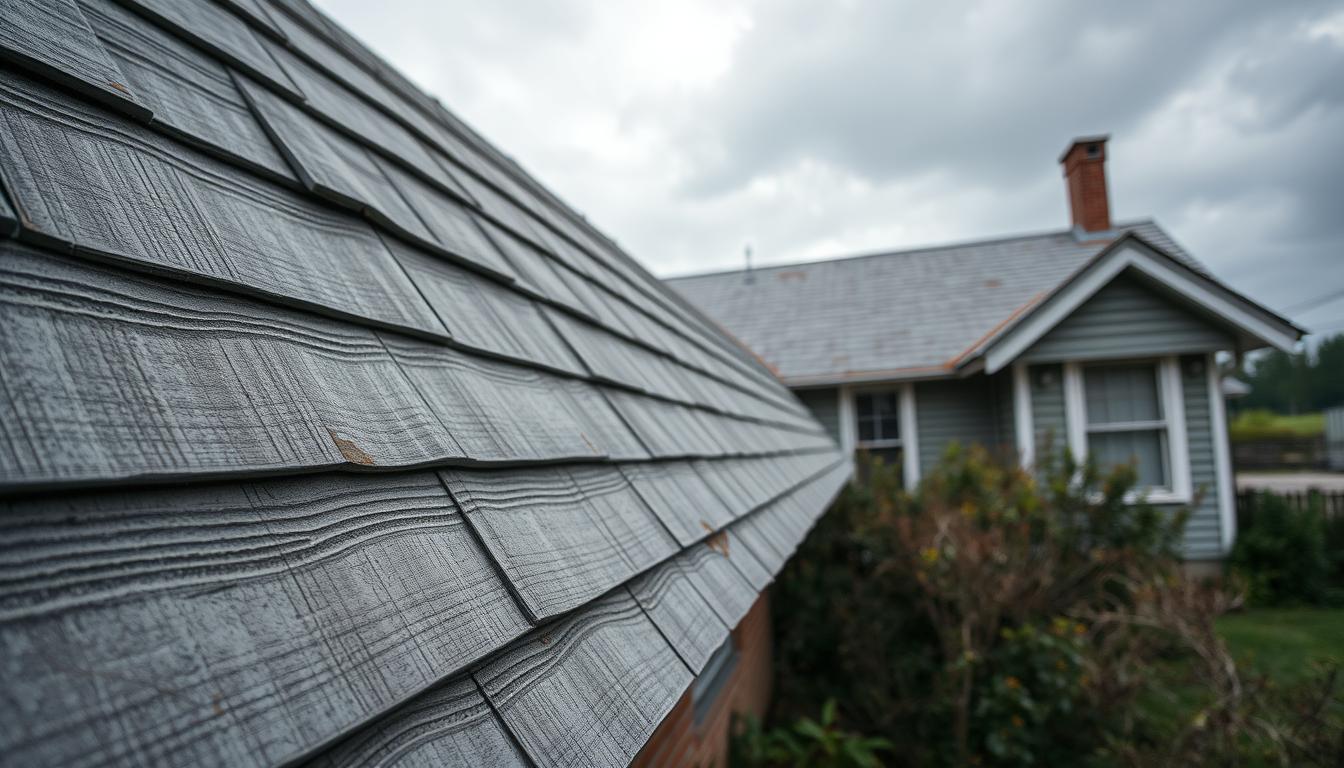Asbestos Siding
Homeowners with asbestos siding face a big problem. This hazardous material is usually not covered by homeowners insurance. Asbestos, once used for its fire-resistant and insulating properties, is now known to be harmful to health.
The presence of asbestos siding can be risky for both the property and its occupants. However, the costs of removing or abating it are not covered by most insurance policies.
Key Takeaways
- Asbestos siding is typically excluded from standard homeowners insurance coverage.
- Asbestos is a hazardous material that can pose serious health risks if disturbed or damaged.
- The costs of asbestos removal or abatement are not covered by most homeowners insurance policies.
- Homeowners with asbestos siding must be aware of the potential property and liability risks associated with this material.
- Proper precautions and professional asbestos removal services are essential for ensuring the safety of homeowners and the environment.
Understanding Asbestos Siding and Its Risks
Asbestos siding, also known as asbestos shingles, was once popular for its durability and fire resistance. But, its use is now banned due to health risks. Exposure to asbestos can cause serious respiratory illnesses, including lung cancer and mesothelioma. This makes it a major concern for homeowners and the insurance industry.
What is Asbestos Siding?
Asbestos siding was used in homes and buildings in the mid-20th century. It was made from asbestos fibers mixed with cement. This made it durable and fire-resistant. But, it’s now seen as a health and environmental hazard.
Health Hazards Associated with Asbestos Exposure
Being exposed to asbestos can lead to serious health problems. These include:
- Lung cancer
- Mesothelioma, a rare and aggressive form of cancer that affects the lining of the lungs or abdomen
- Asbestosis, a chronic lung disease caused by the inhalation of asbestos fibers
- Pleural plaques, which are non-cancerous changes in the pleural lining of the lungs
The risk of these conditions depends on how long and how much you’re exposed to asbestos. Homeowners with asbestos siding face a higher risk, especially during renovations or demolition.
“Asbestos exposure is a serious health concern that can have long-lasting and devastating consequences. Homeowners with asbestos siding must take great care to protect themselves and their families from the risks associated with this toxic material.”
The Exclusion of Asbestos Siding from Homeowners Insurance
Homeowners insurance often doesn’t cover asbestos siding. This is because asbestos is a big risk and can cause serious health problems. It’s also linked to strict environmental laws and high legal costs for property owners.
Insurance companies avoid covering asbestos siding because of the risks and costs. They follow strict underwriting guidelines to manage these risks. This helps them protect their finances.
“Asbestos siding poses a significant risk to both homeowners and insurance providers, which is why it is typically excluded from standard homeowners insurance policies,” explains Sarah Johnson, an insurance industry expert.
Homeowners with asbestos siding need to check their insurance carefully. They should know the limits of their coverage and the costs of asbestos abatement. This knowledge helps them protect their homes and families.
Asbestos Siding Ineligible for Coverage Homeowners Insurance
Homeowners with asbestos siding face a challenge. Their standard homeowners insurance doesn’t cover issues or damage from this material. Insurers see asbestos siding as too risky, so it’s not covered by most policies.
Asbestos siding was once common but is now known to be harmful. It contains asbestos fibers that can be dangerous if disturbed. Even when it’s not damaged, it can still pose risks. But if it gets damaged, it can release these fibers, putting people’s health at risk. This makes insurance companies wary, and they don’t cover it.
Homeowners with asbestos siding can’t file insurance claims for problems with it. This includes costs for fixing, replacing, or removing the siding. It also covers any damage to the property or health issues. Without insurance, homeowners must handle the costs themselves, which can be a big financial burden.
| Homeowner’s Insurance Coverage | Asbestos Siding |
|---|---|
| Damage Repair | Not Covered |
| Replacement | Not Covered |
| Removal | Not Covered |
| Property Damage | Not Covered |
| Health-related Expenses | Not Covered |
The lack of insurance coverage for asbestos siding is a big worry for homeowners. It means they have to deal with the risks and costs themselves. It’s important for homeowners to know what their insurance covers and look for other ways to handle asbestos siding. This helps protect their property and family’s health.
Reasons Behind the Exclusion of Asbestos Siding
Homeowners insurance often doesn’t cover asbestos siding. This is because of strict environmental rules and legal issues. Insurers also worry about damage to property and health risks from asbestos siding.
Environmental Regulations and Legal Liabilities
Asbestos siding must follow strict rules because it’s harmful. Homeowners and contractors must handle, remove, and dispose of it safely. Breaking these rules can lead to big fines and legal problems, making insurers wary of covering properties with asbestos siding.
Potential for Property Damage and Health Risks
- Asbestos siding can get damaged or worn down, raising the chance of toxic fiber release.
- During renovations or natural disasters, asbestos siding can break, spreading harmful fibers. This can contaminate the property and harm people living there.
- Being exposed to asbestos fibers can lead to serious lung diseases like lung cancer, asbestosis, and mesothelioma. This makes insurers very concerned about the health risks of asbestos siding.
With these environmental, legal, and health concerns, it’s clear why insurance companies don’t cover asbestos siding. Homeowners need to understand the dangers and take steps to handle asbestos safely.
Insurance Underwriting Guidelines for Asbestos-Containing Materials
Insurance companies have strict rules for properties with asbestos, like asbestos siding. These rules help them understand the risks. This way, they can decide if they can insure the property.
Underwriters look closely at the asbestos during the insurance process. They check the age, type, and condition of the asbestos. They also think about health and environmental risks. This helps them decide how much to charge for insurance.
| Underwriting Criteria | Potential Impact on Coverage |
|---|---|
| Condition of asbestos-containing materials | Poorly maintained or damaged asbestos materials may lead to exclusion or higher premiums |
| Likelihood of asbestos exposure | Elevated exposure risk may result in exclusion or limited coverage |
| Presence of asbestos removal or abatement plans | Appropriate remediation measures can improve insurability and coverage options |
| Compliance with environmental regulations | Adherence to asbestos-related regulations can impact the underwriting process |
Insurance companies use these strict rules to protect themselves and their customers. They want to avoid big risks and legal problems.
“Insurers take a cautious approach when it comes to insuring properties with asbestos-containing materials, as the potential risks can have far-reaching implications.”
Asbestos Removal and Abatement Costs
Removing asbestos siding can be very expensive for homeowners. It needs special skills and tools to handle and throw away this dangerous material safely.
Professional Asbestos Removal Services
Homeowners usually need to hire experts for asbestos siding removal. These professionals have the right training and safety gear. But, the cost can be high, from $10,000 to $30,000 or more. This depends on the job size and how much asbestos is there.
| Service | Average Cost |
|---|---|
| Asbestos Inspection | $300 – $800 |
| Asbestos Abatement | $10,000 – $30,000+ |
| Asbestos Disposal | $1,000 – $5,000 |
The high cost of asbestos removal is why it’s not covered by homeowners insurance. Homeowners need to plan and budget for these big expenses. It can really affect their money situation.

“Asbestos removal is a complex and costly process that requires the expertise of licensed professionals. Homeowners must be prepared for the significant financial burden that can come with addressing asbestos siding.”
Home Inspections and Asbestos Testing
It’s important for homeowners to check for asbestos siding. This usually means a home inspection and asbestos testing. These steps help figure out how big the problem is and what to do next.
A certified pro can do a detailed home inspection. They look for asbestos siding and check its condition. Knowing this helps homeowners understand the risks and plan a safe fix.
Asbestos testing involves taking samples and sending them to a lab. This test confirms if asbestos is there and what kind it is. Homeowners get the info they need to decide what to do next.
Importance of Asbestos Identification
Knowing if a home has asbestos siding is key for several reasons:
- It helps understand health risks from asbestos
- It shows what steps are needed to fix the problem safely
- It makes sure all rules about handling asbestos are followed
- It protects the home’s value and avoids legal problems
Professional Asbestos Inspection and Testing Services
Homeowners should get help from home inspection and asbestos testing pros. These experts are trained to handle asbestos safely. They give reliable results.
| Service | Description | Benefits |
|---|---|---|
| Home Inspection | A detailed check of the property, including asbestos siding | It gives a full picture of the property’s condition and risks |
| Asbestos Testing | Lab tests of suspected asbestos materials | It confirms if asbestos is there and what kind, helping make informed choices |
Understanding the value of home inspection and asbestos testing helps homeowners protect their families and property. It also safeguards their financial well-being.
Safe Demolition and Renovation Practices
Working with asbestos siding needs careful safety steps. Homeowners and contractors must take steps to avoid asbestos fiber release. This is to prevent serious health issues.
Precautions for Homeowners
It’s wise for homeowners to hire asbestos removal experts. DIY work can spread harmful fibers, risking family health. If you do it yourself, wear the right protective gear and follow safety rules.
- Wear a properly fitted N95 or P100 respirator mask
- Wear protective clothing, including coveralls, gloves, and shoe covers
- Wet the siding thoroughly before removal to minimize dust and fiber release
- Carefully bag and seal all asbestos-containing materials for safe disposal
- Thoroughly clean the work area using wet methods and HEPA-filtered vacuums
Precautions for Contractors
Contractors need training and certification for asbestos removal. They must follow strict safety rules to protect workers and the environment.
- Obtain the necessary permits and comply with all local and federal regulations
- Implement engineering controls, such as negative air pressure systems, to contain asbestos fibers
- Provide workers with appropriate PPE, including respirators, protective clothing, and decontamination facilities
- Properly package and dispose of all asbestos-containing waste in accordance with hazardous materials regulations
- Thoroughly clean the work area and conduct air sampling to ensure the absence of asbestos fibers
By taking these precautions, homeowners and contractors can safely work with asbestos siding. This protects everyone’s health and the environment.
Environmental Concerns and Regulations
Asbestos siding in homes is a big environmental concern because it’s harmful. If asbestos fibers get into the air, they can hurt people’s health. To deal with this, there are strict environmental regulations for handling, removing, and throwing away asbestos. This makes fixing the problem more complicated and expensive.
It’s important to remove and dispose of asbestos the right way to protect the environment. Homeowners need to follow local and federal rules, which often means hiring licensed professionals. If asbestos is not handled correctly, it can lead to legal trouble and more pollution.
Regulatory Oversight and Compliance
The Environmental Protection Agency (EPA) and the Occupational Safety and Health Administration (OSHA) help control asbestos. They have strict rules for finding, handling, and getting rid of asbestos. Homeowners and contractors must follow these rules.
- The EPA’s National Emission Standards for Hazardous Air Pollutants (NESHAP) regulations govern the proper removal and disposal of asbestos-containing materials.
- OSHA’s Asbestos Standard sets safety protocols for workers involved in asbestos abatement and demolition projects.
- State and local authorities may also have additional regulations and permitting requirements for asbestos-related activities.
Not following these rules can lead to big fines and legal problems for homeowners and contractors. It’s important to follow these rules to keep the environment safe and protect everyone involved.
| Environmental Regulation | Key Requirements |
|---|---|
| EPA’s NESHAP | Proper notification, handling, and disposal of asbestos-containing materials |
| OSHA Asbestos Standard | Worker safety protocols, including training and personal protective equipment |
| State and Local Regulations | Additional permitting, disposal, and reporting requirements |
Understanding the rules about asbestos siding is key for homeowners and contractors. It helps keep the community safe and follows the law.
Homeowner Liability and Property Risks
Homeowners with asbestos siding face big risks, especially if the siding gets damaged. This can lead to toxic fibers being released. Insurers are cautious because of the high cost of legal battles and health claims. This is why they often don’t cover asbestos siding.
Homeowners might be sued if people get sick from asbestos fibers. This could be tenants, contractors, or neighbors. The risk of expensive lawsuits makes insurers not want to cover homes with asbestos siding.
Asbestos siding also risks the property itself. Damage can release fibers, contaminating the area. This requires expensive cleanup. Insurers are scared of these costs, which can hurt both homeowners and insurers.
| Potential Liability Risks | Potential Property Risks |
|---|---|
| Lawsuits from exposed individuals Health-related claims Legal and settlement costs | Asbestos fiber release due to damage Contamination of surrounding areas Costly abatement and cleanup |
Insurers are cautious about covering homes with asbestos siding. Homeowners need to take steps to protect themselves. They should make sure they have the right measures in place to avoid these risks.

“Asbestos siding can pose serious health and financial risks to homeowners, which is why insurers are reluctant to provide coverage for properties with this material.”
Alternatives to Asbestos Siding
Homeowners are now aware of the dangers of asbestos siding. They look for safer, durable options that match the look without health risks. These alternatives boost a home’s value and appeal during renovations.
Explore Safer Siding Options
Homeowners have many safe siding choices. Some top picks include:
- Vinyl siding: Affordable and easy to care for, with many colors and styles.
- Fiber cement siding: Strong and fire-resistant, looks like wood or stone without asbestos risks.
- Engineered wood siding: Looks like natural wood but resists moisture, rot, and pests better.
- Metal siding: Long-lasting, in aluminum, steel, or copper, and easy to maintain.
These options are safe, reliable, and improve a home’s look and value during renovations.
Factors to Consider
Choosing a siding alternative requires looking at cost, durability, upkeep, and looks. It’s also key to get professional installation and regular care for lasting safety and performance.
| Siding Material | Durability | Maintenance | Aesthetic Options |
|---|---|---|---|
| Vinyl Siding | Moderate | Low | Wide range of colors and styles |
| Fiber Cement Siding | High | Moderate | Resembles wood or masonry |
| Engineered Wood Siding | Moderate to High | Moderate | Authentic wood appearance |
| Metal Siding | High | Low | Classic and contemporary designs |
Exploring these alternatives helps homeowners make safe, value-adding choices for their home’s look and safety.
“Replacing asbestos siding with a safer, more visually appealing option can not only protect your family’s health but also enhance the curb appeal and value of your home.”
Protecting Your Family and Property
Homeowners with asbestos siding need to act fast to keep their family safe and their property in good shape. It’s key to know the risks of asbestos siding and take steps to prevent them. This ensures the safety and health of everyone living in the home.
Importance of Awareness and Proactive Measures
Asbestos siding can be very dangerous if not handled right. Homeowners should learn about the dangers of asbestos exposure and how to protect their family and property. Getting regular checks and removing asbestos when needed are important steps.
- Learn about the health risks of asbestos siding, like lung cancer and mesothelioma.
- Get professional inspections to find any asbestos in your home.
- Work with licensed contractors to safely remove and dispose of asbestos siding.
- Make sure any work on asbestos siding is done by trained professionals.
By taking these proactive measures, homeowners can protect their family’s health and safeguard their property from asbestos siding risks. Being aware and acting quickly helps keep your home safe and healthy.

“Addressing the risks of asbestos siding is not only a matter of protecting your family’s health, but also preserving the long-term value and integrity of your home.”
Insurance Coverage Options for Asbestos Removal
Standard homeowners insurance usually doesn’t cover asbestos siding. But, there might be other insurance options to help with asbestos removal costs. Homeowners should look into these and talk to their insurance providers to find insurance coverage that works for them.
One option is a specialized environmental insurance policy. This type of policy can cover the costs of asbestos inspection, testing, and removal. It’s important to check the policy’s terms and what’s not covered to make sure it fits your needs.
Another choice is liability insurance. Some insurers offer policies that protect homeowners from legal issues related to asbestos on their property. This is especially useful for homeowners who want to sell their home or do renovations that involve asbestos removal.
| Insurance Coverage Option | Key Benefits | Potential Limitations |
|---|---|---|
| Environmental Insurance Policy | Covers asbestos inspection, testing, and professional removal costs Protects against environmental liabilities | Policy terms and exclusions vary May require specific underwriting criteria |
| Liability Insurance | Protects against legal liabilities related to asbestos-containing materials Helpful for homeowners planning to sell or renovate | Coverage may be limited Premiums can be costly |
Looking into these insurance coverage options can help homeowners manage the costs of asbestos removal. It also helps protect their property and family’s health.
Navigating the Claims Process
Homeowners dealing with asbestos siding insurance claims face a tough journey. It’s key to know what your policy covers and what you need to prove your case. This knowledge is vital for a smooth claims process.
Start by carefully reading your insurance policy. Look for any parts that exclude or limit coverage for asbestos siding. Many policies don’t cover the removal or fixing of asbestos materials, including siding.
- Gather Necessary Documentation: Collect important documents like:
- Proof of home ownership
- Reports or tests showing asbestos siding
- Quotes from licensed contractors for removal and disposal costs
- Submit a Detailed Claim: When you file your claim, describe the problem, the damage, and your plan to fix it. Be clear and accurate.
- Obtain Professional Assistance: Talking to a public adjuster or insurance attorney can help. They know how to get you the most from your policy.
The process for asbestos siding claims is complex. But, being proactive and informed can help. Stay focused and work with your insurance company to find the best solution for you.
| Key Steps in the Insurance Claims Process | Description |
|---|---|
| Review Insurance Policy | Find out if your policy covers asbestos siding |
| Gather Documentation | Get proof of ownership, inspection reports, and contractor quotes |
| Submit Detailed Claim | Describe the problem and your fix plan clearly |
| Seek Professional Assistance | Get help from a public adjuster or attorney |
“Navigating the insurance claims process for asbestos siding can be a complex and challenging endeavor, but with the right approach and support, homeowners can increase their chances of a successful outcome.”
Conclusion
Asbestos siding in homes is a big risk. It can damage property and harm health. Since insurance often doesn’t cover it, homeowners need to act fast to protect their homes and families.
Knowing the dangers of asbestos siding is key. Homeowners can look into safer siding choices and deal with insurance claims. This helps reduce the cost of fixing the problem.
Dealing with asbestos siding needs a careful plan. It’s about being aware, staying safe, and planning well. By doing so, homeowners can keep their property safe, their family healthy, and their investment secure.
FAQ
What is Asbestos Siding?
Asbestos siding, also known as asbestos shingles, was once popular for its durability and fire resistance. However, it’s now banned due to health risks. Exposure to asbestos can cause serious illnesses like lung cancer and mesothelioma.
Why is Asbestos Siding Ineligible for Coverage in Homeowners Insurance?
Homeowners insurance often doesn’t cover asbestos siding. This is because of the high risks and legal issues it poses. Insurers don’t want to deal with the potential damage and health problems it can cause.
What are the Reasons Behind the Exclusion of Asbestos Siding from Homeowners Insurance?
Asbestos siding is excluded from insurance due to environmental laws and legal risks. Insurers are also concerned about the damage and health risks it can cause. This includes the release of toxic fibers during renovations or disasters.
How Do Insurance Companies Assess the Risks of Asbestos-Containing Materials?
Insurance companies have strict rules for asbestos siding. They use these guidelines to understand the risks and potential legal issues. This helps them decide not to cover it in standard homeowners insurance.
What are the Costs Associated with Asbestos Removal and Abatement?
Removing asbestos siding is expensive and complex. Homeowners often need to hire professionals, which can be costly. The high removal costs are another reason insurance doesn’t cover it.
How Can Homeowners Identify the Presence of Asbestos Siding?
Finding asbestos siding in a home is important. Homeowners should get a professional inspection and asbestos test. This helps figure out the extent of the problem and what to do next.
What Safety Precautions Should Homeowners and Contractors Take When Dealing with Asbestos Siding?
Working with asbestos siding requires careful safety steps. Homeowners and contractors must take precautions to avoid releasing asbestos fibers. This is crucial to prevent serious health issues.
What Environmental Concerns and Regulations Surround Asbestos Siding?
Asbestos siding poses environmental risks due to its hazardous nature. Strict laws govern its handling, removal, and disposal. This adds to the complexity and costs of dealing with it.
What Liability Risks Do Homeowners Face with Asbestos Siding?
Homeowners with asbestos siding face liability risks. If the material is damaged or disturbed, it can release toxic fibers. Insurers are cautious of these risks, which can lead to legal and health claims.
What are the Alternatives to Asbestos Siding?
Homeowners should consider safer siding options without asbestos. These alternatives offer similar benefits but ensure safety and protection for the property and its occupants.
How Can Homeowners Protect Their Family and Property from Asbestos Siding?
Homeowners with asbestos siding must take steps to protect their family and property. They should be aware of the risks and take action, like professional inspections and removal. This ensures the safety of their home and loved ones.
Are There Any Insurance Coverage Options for Asbestos Removal?
While standard insurance often excludes asbestos siding, there might be other options. Homeowners should look into these alternatives and talk to their insurance providers to find coverage.
How Can Homeowners Navigate the Insurance Claims Process for Asbestos Siding?
Filing an insurance claim for asbestos siding can be tough. Homeowners should understand their policy’s exclusions and what documentation is needed. This helps them navigate the claims process more effectively.




2 Responses